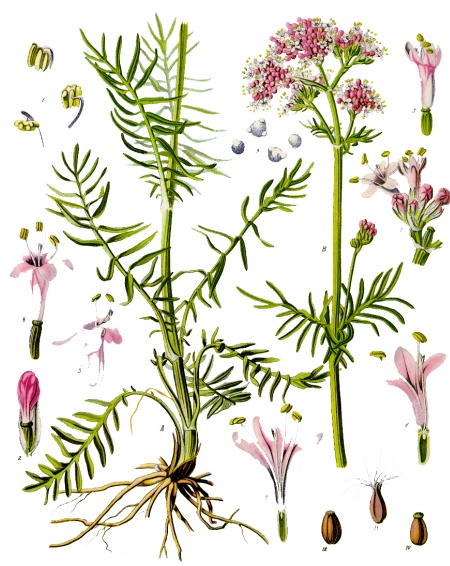
Valeriana officinalis (L)
Synonyms and Common names: all-heal, set-well, English valerian, Belgian
valerian, common valerian, German valerian, wild valerian, heliotrope, garden
heliotrope, fragrant valerian, vandal root, phu (Galen), amantilla, capon's tail
French = Herbe aux chats, German = Baldrian, Spanish = Valeriana, Italian = Amantilla
Order: Valerianaceae
Description: Valeriana is a common perennial herb, up to 1.5m tall, with erect, fluted stems. The leaves are pinnate with 9-21 lanceolate segments up to 7cm long, with a few coarse teeth and some hairs underneath. The leaves are more infrequent and opposite higher up the stem. The rootstock is short, giving off a tuft of long creeping runners. The stems terminate in broad corymbs of numerous small flowers, white tinged with pink, funnel-shaped with five unequal lobes. Valeriana grows well in moist situations throughout Europe and north to the Arctic Circle.
Parts used: dried rhizome, roots and stolons.
Collection: The rhizome and roots should be collected in October and November and dried slowly in the shade.
Constituents: 1% volatile oil (including valerianic acid, isovalerianic acid, valerenone, valerenal, hydroxyvaleric acid, citronellyl isovalerate, borneol, pinene, camphene, methyl-2-pyrrole ketone and assorted sesquiterpenes), epoxy iridoid esters (valepotriates, including valtrate and didovaltrate, which are rapidly lost during storage), glycoside (valerosidatum), volatile pyridine alkaloids (valerine, valerianine, actinidine, chatinine), choline, flavonoids, sterols, phenolic acids, sugars, fixed oil, resin, gum
Actions: Sedative, relaxant, mild anodyne, hypnotic, spasmolytic, carminative, hypotensive, expectorant, diuretic, warming
Indications: Hysterical states, excitability, insomnia and disturbed sleep patterns, hypochondriasis, migraine, cramp, intestinal colic, rheumatic pains, dysmenorrhoea. Specifically indicated in conditions presenting nervous excitability.
Therapeutics and Pharmacology: Valeriana is used to reduce tension and anxiety, over-excitability and hysterical states. It is calming without exerting too sedative an effect and is practically non-addictive. It is a valuable treatment for insomnia, the sedative effect due to the valepotriates and the isovaleric acid, which is also responsible for the characteristic smell of valerian. Documented research has noted a mild hypnotic action in both normal sleepers and insomniacs, indicated by a beneficial effect on sleep latency, wake-time after sleep, frequency of waking, nocturnal motor activity, inner restlessness and tension and quality of sleep. Sleepiness and dream recall the morning after were unaffected. The valepotriates have a regulatory effect on the autonomic nervous system - one fraction has a suppressant effect, another a stimulant one, so that in combination they have an amphoteric effect. The valepotriates have an antispasmodic action too, making the herb an appropriate remedy where pain is associated with tension. It helps relieve dysmenorrhoea and it can be of benefit in migraine and rheumatic pain. It may also be applied locally as a treatment for cramps and other muscle tensions.
Valeriana may used as an expectorant to help relieve tickling, nervous coughs. It also has a strengthening action on the heart, and experiments indicate that it can lower blood pressure. Tincture of valerian is reputed to clear dandruff.
Combinations: Valeriana combines well with Viscum and Scutellaria in hysteria; with Humulus and Passiflora in insomnia; with Viburnum opulus in cramps; and with Dioscorea, Caulophyllum and Anemone in dysmenorrhoea. Valeriana in combination with Hypericum has been reported to be more effective than diazepam in treating symptoms of anxiety when given to 100 patients for two weeks in a double-blind clinical trial.
Caution: Continual use, or high doses of Valeriana may cause headaches, dizziness, muscular spasm and palpitations. It can also enhance the action of sleep-inducing drugs and therefore should not be taken in conjunction with this type of medication. The plant should not be confused with American valerian, Centranthus ruber, which has no medicinal value.
Preparations and Dosage: (thrice daily)
Regulatory Status: GSL Schedule 1
Dried rhizome and roots: 1-3g or by infusion or decoction
Liquid Extract (BPC 1963): 1:1 in 60% alcohol, 0.3-1ml
Tincture Simple (BPC 1949) 1:8 in 60% alcohol, 4-8ml
Tincture: 1:5 in 70% alcohol, 3-5ml
Concentrated infusion (BPC 1963) 1:5 in 25% alcohol, 2-4ml
Additional Comments: Dioscorides and Galen extolled valerian as an aromatic and diuretic. Its name may derive from Valerius, who first used it medicinally; or possibly from the Latin valere, to be in good health. The early European herbalists valued valerian for its expectorant and diuretic properties. During the Second World War, shell-shock and 'bombing neurosis' were treated with valerian. In China it is prescribed for influenza, rheumatism, insomnia, apprehension and traumatic injuries. Cats are attracted to valerian, which can induce a state of ecstasy in them. Rats, too, are attracted by it, and it was used in the past as bait by rat-catchers.
Bibliography
Bartram, T. 1995 Encyclopaedia of Herbal Medicine, 1st edn., Grace Publishers, Bournemouth.
Bradley, P.R. (ed.) 1992 British Herbal Compendium, Volume 1, BHMA, Bournemouth.
Bremness, L. 1994 Herbs, Dorling Kindersley Eyewitness Handbook, London.
BHMA 1983 British Herbal Pharmacopoeia, BHMA, Bournemouth.
Chevallier, A. 1996 The Encyclopaedia of Medicinal Plants, Dorling Kindersley, London.
Corrigan, D. 1996 Herbal Medicine: Sleep and Relaxation, Amberwood Publishing, Christchurch
Grieve, M. 1931 A Modern Herbal, (ed. C.F. Leyel 1985), London.
Hoffmann, D. 1990 The New Holistic Herbal, Second Edition, Element, Shaftesbury.
Hyperhealth 1996 Natural Health and Nutrition Databank, v.96.1 CD-ROM, �In-Tele-Health, available from Healthworks, Leeds. ISBN 0-646-30942-0
Lust, J. 1990 The Herb Book, Bantam, London.
Mabey, R. (ed.) 1991 The Complete New Herbal, Penguin, London.
Mills, S.Y. 1993 The Essential Book of Herbal Medicine, Penguin, London (First published in 1991 as Out of the Earth, Arkana)
Mills, S.Y. 1993 The A-Z of Modern Herbalism, Diamond Books, London.
Newall, C.A., Anderson, L.A., & Phillipson, J.D. 1996 Herbal Medicines: A Guide for Health-care Professionals, The Pharmaceutical Press, London.
Ody, P. 1993 The Herb Society's Complete Medicinal Herbal, Dorling Kindersley, London.
Polunin, M. and Robbins, C. 1992 The Natural Pharmacy, Dorling Kindersley, London.
Prihoda, A. 1989 The Healing Powers of Nature, Octopus, London.
Weiss, R.F. 1991 Herbal Medicine, Beaconsfield Arcanum, Beaconsfield.
Wren, R.C. 1988 Potter's New Cyclopaedia of Botanical Drugs and Preparations, C.W.Daniel, Saffron Walden.










